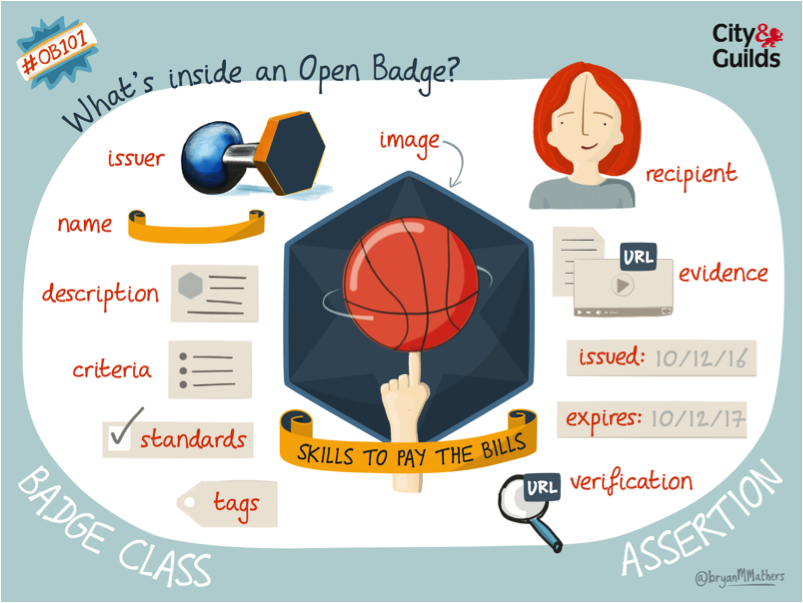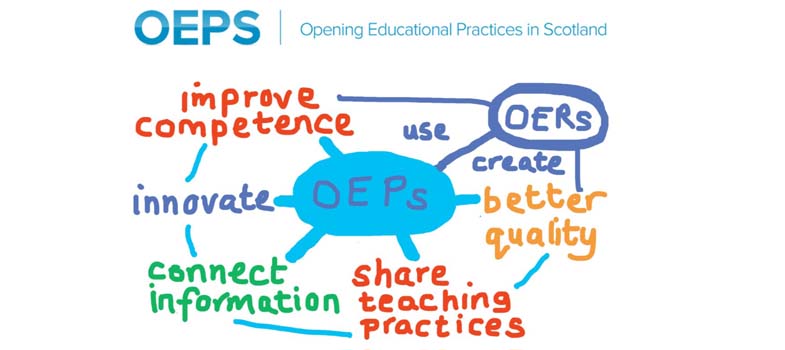Open Badges, Recognition and Credit
This briefing is one of a series produced by the Opening Educational Practices in Scotland (OEPS) project. OEPS was a three-year cross-sector project to facilitate best practice in Scottish open education. The project was concerned with the use of openly licensed educational materials, widening participation and social justice. This briefing and others in the series reflects the focus and objectives of the project.
Executive Summary
- Open Badges are digital credentials that can be saved and shared by their owner.
- The use of Open Badges in Scotland is growing. The informal learning sector is leading the way.
- Students applying to colleges and universities may already have a portfolio of Open Badges.
- Badges are being used to recognise professional development or supplement formal curriculum by recognising extra and co-curricular activity. Free, open, online, badged courses are becoming available in large numbers.
- Badges may be awarded as a result of work submitted to an appropriate assessor or through computer marked quizzes. The latter allows for greater scale and flexibility but narrows the assessment options.
- Badges are typically awarded for activity that supports educational transitions. Innovative approaches to linking digital credentials with formal credit are beginning to emerge.
What are Open Badges
Issuing paper certificates to confirm that an individual has successfully completed an episode of learning is well established. Digital platforms allow this approach to be extended to the provision of digital certificates. In addition to downloadable documents in Word or PDF format there is increasing use of digital badges. A digital badge is an online version of the kinds of badges used by organisations like the Scouts and Guides to recognise achievement.
The use of digital badges began to grow from 2011 following the release of a report by the Mozilla Foundation and the Peer 2 Peer University. Subsequently Mozilla released the first version of technical standards for incorporating metadata with the badge image. Metadata stores information about the nature of the learner’s achievement. Digital Badges adhering to these standards are known as Open Badges.

What’s inside an Open Badge by @bryanMMathers is licenced under CC-BY-ND
The development of Open Badge standards has now been taken over by the IMS Global Learning Consortium. There are a number of software options available that enable users to store, manage and share badges that they have earned. One of the most widely used is the Mozilla Backpack.
Developments in Scotland
Open Badges are a new form of accreditation. The ways in which they are used continue to involve and their relationship to more traditional forms of accreditation remains an issue of debate. Initially discussion of Open Badges took place at a national level through the Open Badges in Scottish Education Group (OBSEG) with the active involvement of the Scottish Qualifications Authority. OBSEG no longer exists but activity across Scotland continues to grow. Much of the interest in the use of Open Badges is located outside the college and university sectors.
The use of Open Badges in Scotland falls into three main categories.
1. Awarding badges for the recognition of activity that contributes to continuing professional development (CPD).
Borders College was an early adopter of this approach with local employers and City of Glasgow College uses badges to recognise professional development for their own staff. The Scottish Social Services Council (SSSC) has launched a major initiative with the development of the SSSC Open Badges website. The OEPS project has worked with a number of organisations including Parkinson’s UK and Dyslexia Scotland to co-design badged courses that support professional development.
2. The recognition of co-curricular and extra curricular activity.
The University of Abertay is using open badges with its Law students. Under the aegis of QAA Scotland’s Transitions Enhancement Theme, Abertay is working with the Universities of Aberdeen and Dundee to explore how using badges to recognise co- and extra-curricular activities in this way supports student employability. There is interest in integrating badges with the Higher Education Achievement Record (HEAR).
3. To reward the successful completion of an openly licensed online course.
The Open University now offers a suite of badged online courses (BOCs) on OpenLearn that are designed to support transitions. The OEPS project worked in partnership with Scottish Universities and Third Sector organisations to co-design a range of badged open courses. These courses are all hosted on the community site OpenLearn Create.
Assessment models
The assessment landscape is diverse and continues to evolve. Open Badges are awarded against a wide range of criteria. In some cases this may simply be for attendance or participation at a face-to-face event, or engagement with an online activity. However, badges are also awarded for successful completion of an assessment activity judged against predefined criteria. In view of the range of meanings that can be attached to a badge some organisations are looking for other ways of describing this form of digital recognition of achievement. So for example Digital Me, which focuses on employability skills for young people, is moving to the use of ‘digital credential’ rather than ‘badge’.
There is a variety of practice in relation to assessment. The Scottish Social Services Council has developed an approach that involves assessment of submitted work by an appropriately qualified individual. The SSSC’s pedagogic model is based on using badges to recognise situated learning. Badges are awarded for reflecting and acting on learning, not simply for attendance or participation. Assessment and verification of reflective activity is carried out by employers, line managers and sometimes by SSSC staff. Social care organisations can register with the system and are allocated a unique code. Learners can then submit the code for their particular employment and will be assessed by someone with knowledge of their context. SSSC samples and monitors assessment to ensure consistency of standards. The scalability of the model depends on the active engagement of organisations working with the SSSC.
Assessment that involves human intervention becomes more difficult (and more costly) when badges are awarded for free open, online courses that can be studied by anyone with an internet connection. The badged open courses offered by the Open University on OpenLearn and by a range of providers on OpenLearn Create are of a form which provide a solution for this problem of marking online assessment without needing human support. Participants complete computer marked quizzes and badges are awarded against specified criteria with no need for human intervention. Criteria can include not just thresholds for the quiz assessment but also automatic logging of students’ engagement with specific activities or sections of the course. Quizzes are not an effective way of assessing deep learning. However, the OEPS experience suggests that carefully designed formative and summative quizzes can reinforce student motivation and encourage engagement active learning and reflection that supports deep learning.
Badges and credit
Badges are often referred to as micro-credentials. Most badges are awarded for just a few hours of learning; typically in the range 5 – 25 hours (although there are a few outliers at both ends of the range). Consequently the potential credit value of a single badge is small. However, the significance of credit is contextual. While for a graduate, 1 or 2 credit points at for example, SCQF level 7, might not be relevant, for an adult learner with little or no post school educational credentials it may be more significant.
Digital credentials are forming an increasingly common part of learner journeys and it’s therefore worth exploring how micro credentials in the form of Open Badges might be integrated with more formal credit based approaches. Simply accumulating multiple tiny packages of credit has the potential to fragment the learner journey. The prospect of gaining a substantial qualification in such a way would be daunting to the most experienced learner. Current trends suggest that badged open courses and other experiences leading to the award of an Open Badge are typically part of the in-between space in the curriculum and so there is a need to consider how badged learning can effectively support transitions.

Credentials big and small… by @bryanMMathers is licenced under CC-BY-ND
One approach that is being piloted by the Open University makes use of a formally accredited ‘empty box’ module. ‘Making Your Learning Count’ is a 30-credit module at SCQF level 7, which allows students who have studied badged open courses to reflect on their learning, make interdisciplinary links and develop new skills. The module links prior informal badged learning with accredited study by recognising and valuing the non-accredited study while using it as a launch pad for further formal study.
Useful Links
https://www.openbadgeacademy.com
Pete Cannell (for the OEPS project team)
22 June 2017
Download this briefing as a or as a
